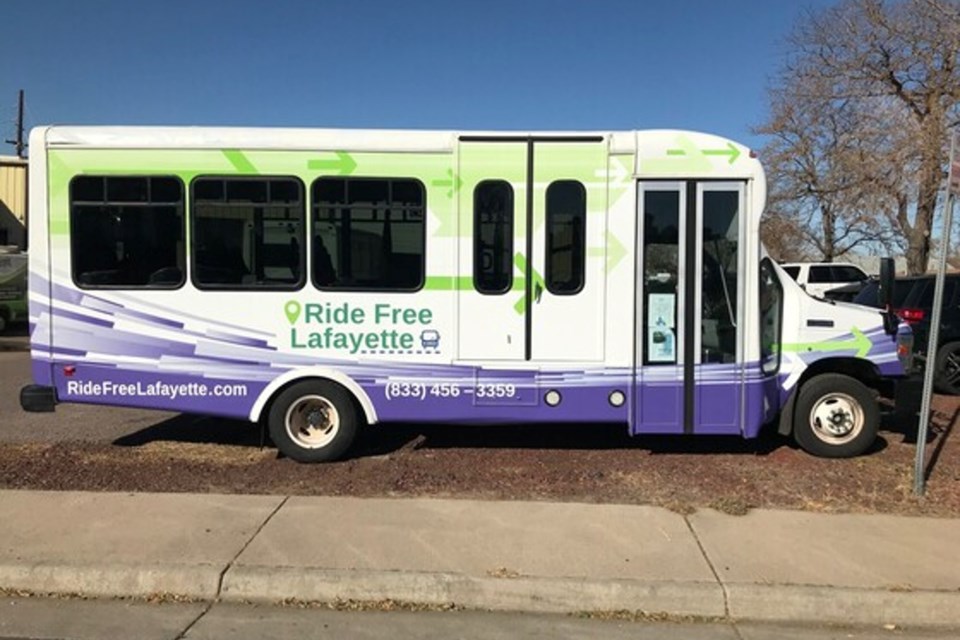NEWS RELEASE
BOULDER COUNTY
*************************
Starting July 5, Boulder County is encouraging residents to ride transit to help keep Colorado’s air clean during the summer months when air pollution is at its highest.
Boulder County is participating in the Zero Fare For Better Air, We’ll Get You There effort to promote public transit during the months of July and August.
The effort is made possible by Colorado Senate Bill 22-180, the Ozone Season Transit Grant Program in partnership with the Colorado Energy Office.
Boulder County welcomes individuals who may have never used its transit services and customers who are regular transit users to ride often all summer long and save money getting where they need to go. The county is participating in the effort by expanding two of our fare-free services: Ride Free Lafayette and the Lyons Flyer.
Ride Free Lafayette provides on-demand transit service within the City of Lafayette seven days per week including holidays. From July 5 to Aug. 31, 2023, Boulder County will add one additional vehicle for three hours each weekday morning, from 8 to 11 a.m. The additional vehicle will result in decreased wait times for passengers and improved reliability of the service in the morning hours.
The Lyons Flyer provides weekday transit service between the town of Lyons and the city of Boulder. From July 5 to Aug. 31, 2023, Boulder County will add a fourth, midday round trip between Lyons and Boulder. The proposed service expansion will increase flexibility for passengers by making half day trips between Lyons and Boulder possible.
Both Ride Free Lafayette and Lyons Flyer are operated under contract by Via Mobility Services, a local non-profit that provides accessible transportation services.
The additional service for these routes is being funded by the state’s Ozone Season Transit Grant program, while the base funding for these routes comes from the Boulder County Transportation Sales Tax, RTD, and other grants.
Residents and visitors are also encouraged to consider Boulder County’s other transit services, including the Gold Hill Climb (commuter service between Gold Hill, Salina, Fourmile, and Boulder), the Hessie Shuttle (hiker shuttle to Lost Lake and Indian Peaks Wilderness) and the Eldo Shuttle (shuttle to Eldorado Canyon State Park and the Marshall Mesa, Doudy Draw and South Mesa Trailheads).
In addition to expanding Boulder County’s service, the county is supporting the regional Zero Fare for Better Air effort led by RTD in July and August.
“Free public transit is an important tool for reducing ozone and pollution from passenger vehicles. In addition, free public transit is a great opportunity for new riders to try the bus or train for the first time and also improve access for people on a fixed income who are unable to meet all their transportation needs due to the cost of fares” said Claire Levy, Boulder County commissioner.
“The pilot program that launched August of last year was highly successful. Transit systems from all over the state participated, ranging from those serving the largest cities like RTD in Denver to regional rural systems like SMART in San Miguel County (Telluride region). Mid-size cities throughout Colorado, like Greeley, Pueblo and Colorado Springs participated in the program. Smaller communities in mountain towns, the eastern plains and western slope also took advantage of this amazing opportunity," said executive director of Colorado Association of Transit Agencies (CASTA), Ann Rajewski.
“All agencies that participated increased ridership — ranging anywhere between two to 59%. This year we are expanding the program for the entire summer and are expecting to increase the number of transit agencies participating,” she added.
Approximately 85% of the greenhouse gas emissions that come from transportation are due to day-to-day commutes. By leaving the car at home, a person can save up to 20 pounds of carbon dioxide emissions every day depending on the length of the trip.
Additional customer benefits of the Zero Fare program are substantial. Riders experience environmental, financial, lifestyle and community benefits of transit that include:
Increased accessibility
Public transportation provides rides and accessibility to those who have difficulty driving or are not physically able to drive. Transit provides a high quality of life for those with disabilities allowing them to live an active lifestyle and access key services like medical, work, shopping and social activities.
Cost savings
Taking the bus saves on car expenses including maintenance and parking which add up quickly. Not only do you save money on gas, but you also reduce the wear and tear on your vehicle. According to a recent study by AAA, a new car’s routine maintenance and repairs could cost an average of $0.09 per mile. If you drive 10,000 miles in a year, that totals $900. If you drive 20,000 miles, that figure jumps to $1,800 annually.
Gas savings
Riding public transit frees up additional funds in customers’ everyday budgets. In addition, public transportation saves the U.S. an estimated 4.2 billion gallons of gas annually reducing our dependence on foreign oil.
Reduction in traffic
Taking public transit keeps cars off the road, limiting traffic congestion, air pollution and ground-level ozone. Colorado’s population grew 39% over the past 20 years and is expected to grow another 30% in the next 20, significantly increasing traffic around the state. This robust growth makes it essential for commuters to have public transit options to offset the increase in traffic and increased distances to work.
Reduction in stress and increased safety
Taking public transit removes the stress and anxiety of battling everyday traffic. Public transportation is one of the safest ways to travel and it is ten times safer per mile than traveling by car.
Increased productivity
While taking public transit, customers can catch up on reading, emails, podcasts or just sit back and relax.
Improved air quality
Transportation is a major source of greenhouse gas emissions causing climate change. Using public transit creates 84% less carbon emissions than driving a car. That is a savings of 63 million metric tons annually.
*************************



